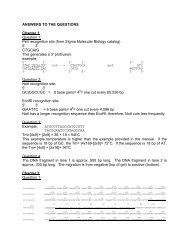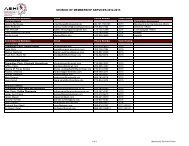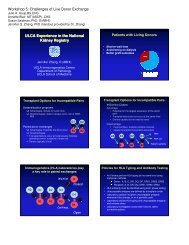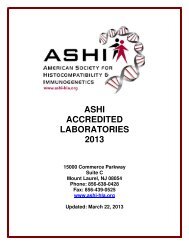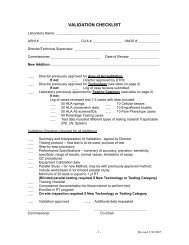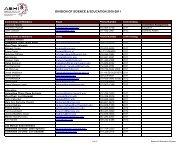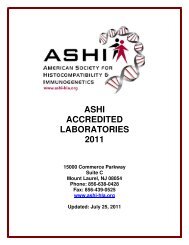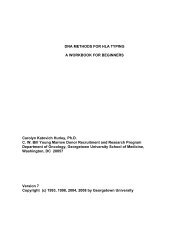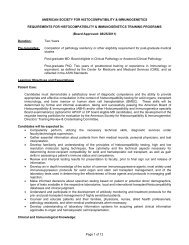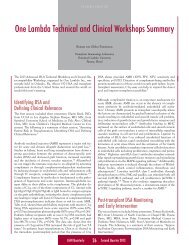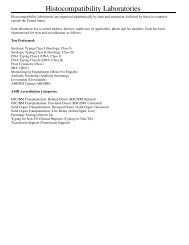immunosuppression (IS) <strong>for</strong> 3 months is converted to sirolimus (SRL) and MMF followed by ISwithdrawal, first MMF and then SRL at 12-30 months post-op. Serial PBMC flow immunophenotyping(IP) and sequential Treg-MLR inhibition/recruitment assays are per<strong>for</strong>med. In the Treg-MLR,cryopreserved recipient pre-RT PBMC (CFSE labeled) respond to irradiated donor or third partystimulating PBMC in the presence of (cryopreserved) pre- vs post- RT recipient PBMC as modulators.Then, lymphoproliferation and newly generated (recruited) CD4 + CD25 high FOXP3 + responding cells aremeasured by flow.Results: The first 4 patients are now between 18 and 30 months post-op with IS (SRL monotherapy)dosing ranging from none to 1 mg QOD with no rejection (clean 1 & 2 year biopsies and no cell growth inbiopsy cultures). Immunophenotyping of PBMC indicated that the (CD1<strong>27</strong> - ) CD4 + CD25 high FOXP3 +(natural) Tregs increased >3X in recipient PBMC up to 30 months post-RT. In the Treg-MLR, recipientPBMC from 1 year post-RT inhibited anti-donor cell proliferation and increased the proportion(recruitment) of newly developed donor-specific recipient responder CD4 + CD25 high FOXp3 + cells by 10-fold (n=4). Chimerism transiently reached 3% in some recipients at 3 to 6 months (real-time quantitativePCR assay).Conclusions: DHSC in AL treated HLA-identical RT recipients converted from TAC & MMF to SRL andthen IS withdrawn, is associated with high PBMC Tregs, and in the Treg-MLR with donor-specificinhibition and Treg recruitment.23-ORKIR3DS1-2DS1-2DS5, RECEPTORS IMPLICATED IN NK CELL ACTIVATION PROVIDE ARISK OF DEVELOPING ADVANCED STAGE BREAST CANCER.Elham Ashouri 1 , Abbas Ghaderi 1 , Raja Rajalingam 2 . 1 Shiraz Institute <strong>for</strong> Cancer Research, ShirazUniversity of Medical Sciences, Shiraz, Islamic Republic of Iran; 2 UCLA Immunogenetics Center,Department of Pathology and Laboratory Medicine, David Geffen School of Medicine at UCLA, Universityof Cali<strong>for</strong>nia at Los Angeles, Los Angeles, CA, USA.Aim: Polymorphic KIRs are the key receptors of human NK cells that trigger early immune responseagainst infection and tumors. Here we investigated if certain KIR genes are associated with breast cancer.Methods: DNA from 167 women with breast cancer diagnosed at the multidisciplinary breast cancer unitof Shiraz Institute <strong>for</strong> Cancer Research, Iran, and <strong>27</strong>8 healthy controls from the same geographical areawere typed <strong>for</strong> 16 KIR genes using a duplex-PCR typing system.Results: The frequency of Bx genotypes that possess 2-6 activating KIR genes were predominant in thepatients compared to the controls (84.4% vs. 72.6%, P = 0.<strong>00</strong>5; 95% CI, 1.24-3.34, OR = 2.04). ActivatingKIR genes, 3DS1 (46.7% vs. 34.1%, P = 0.<strong>00</strong>9; 95% CI, 1.14-2.5, OR = 1.68), 2DS1 (55.6% vs. 36.3%, P= 0.<strong>00</strong><strong>00</strong>7; 95% CI, 1.48-3.25, OR = 2.2) and 2DS5 (42.5% vs. 25.5%, P = 0.<strong>00</strong>02; 95% CI, 1.43-3.24, OR= 2.15) were significantly increased in breast cancer compared to the controls. Particularly, 36.4% of thepatients carried all these three activating KIR genes compared to only 21.4% controls (P = 0.<strong>00</strong>067; 95%CI, 1.37-3.2, OR = 2.09). Notably, 41.8% of the patients with advanced stage III cancer carried all thesethree KIRs.Conclusions: These findings contrast the classical view that activating NK cell receptors mediatespontaneous lysis of tumor trans<strong>for</strong>med cells. NK cells expressing 3DS1-2DS1-2DS5 may trigger alocalized hyperresponsiveness exacerbating cancer growth. Consistent with this findings, a detrimental role<strong>for</strong> NK cells against cancer and non-viral pathogens has been suggested from the following studies:increased 3DS1 in patients with cervical neoplasia (J Exp Med 2<strong>00</strong>5, 201:1069), depletion of NK cellsincreased the ability of the host to control L.Monocytogenes (J Immunol 1994, 152:1873); host NK cells arenecessary <strong>for</strong> the growth of human filarial parasite B.Malayi (J Immunol 1998, 161:1428).24-OREFFECT OF KILLER CELL IMMUNOGLOBULIN LIKE RECEPTOR (KIR) AND HUMANLEUKOCYTE ANTIGEN (HLA) LIGAND INCOMPATIBILITY ON HUMAN RENALTRANSPLANTATION: ASSOCIATION WITH ARTERIAL THICKENING AND TUBULITIS.Faisal M. Khan 1,2 , Jagdeep Doulla 2 , Meena Assad 2 , Aylin Sar 2 , Ipek I. Gonul 2 , Serdar Yilmaz 2 , NoureddineBerka 1,2 . 1 Calgary Laboratory Services, Calgary, AB, Canada; 2 University of Calgary, Calgary, AB,Canada.
Aim: NK cells have an established role in defense against tumors, viral infection and outcomes of HCT buttheir importance in solid organ transplantation is restricted to the reports showing increased numbers ofcirculating and graft interstitium infiltrating NK cells during acute rejection of renal allograft. Theactivation and inhibition of NK cells depend on the interaction of killer immunoglobulin like receptors(KIRs) with HLA class I molecules expressed on target cells. Here we assessed the impact of recipient KIRand donor HLA incompatibility on occurrence of acute kidney allograft rejection and histological scoreindicative of allograft failure.Methods: A total of 135 kidney transplant recipients were genotyped <strong>for</strong> 16 KIR genes by a multiplex KIRgenotyping assay using Genprobe KIR genotyping kit. Incidence of acute rejection and eleven individualhistological parameters scored in 6-12-months post-transplant surveillance biopsies were utilized as clinicalend points in the analysis.Results: Recipient KIR – donor HLA incompatibility was found associated with high scores <strong>for</strong> arterialthickening and tubulitis, but not with acute rejection. Recipient KIR2DL3 pos and donor HLAC1 negincompatibility was associated with high scores <strong>for</strong> arterial thickening (p=0.026) and recipient KIR3DL2 posand donor HLA-A3/A11 neg incompatibility was correlated with high scores <strong>for</strong> tubulitis (p=0.04).Conclusions: The allogeneic interaction between recipient KIR and donor HLA antigens may constitute arisk of kidney allograft failure. NK cell mediated response may represent another potent mechanism ofallo-immunity in solid organ transplantation though not as critical as T cell mediated allo-immunity.<strong>Monday</strong>, <strong>September</strong> <strong>27</strong>, <strong>2010</strong>5:30 <strong>PM</strong> - 7:<strong>00</strong> <strong>PM</strong>Poster Session1-PCONSIDERATIONS IN INTERPRETING SOLID PHASE ANTIBODY DATA.Jessica L. Badders, Julie A. Houp, Jeffrey T. Sholander, Mary S. Leffell, Andrea A. Zachary. Medicine,Johns Hopkins University, Baltimore, MD, USA.Aim: Solid phase immunoassays provide rapid detection of HLA-specific antibodies with unprecedentedsensitivity and specificity. However, interference in the assays may be caused by extrinsic factors such astherapeutic agents and intrinsic factors such as non-specific binding of IgM and immune complexes. Theaim of this study was to evaluate factors affecting the results of solid phase immunoassays.Methods: Sera, untreated and treated to eliminate IgM, were tested by solid phase assay on the Luminexplat<strong>for</strong>m. Results were analyzed by two or more experienced individuals.Results: Examples of the effect of these are shown in the table.[table1]Reactivity of the controls and testserum can be affected appreciably by the treatment used to eliminate intrinsic factors and we have reportedsignificant differences in the effects of DTT treatment and hypotonic dialysis. Daily variation in reactivityof pooled antigen assays can vary up to 30% and we have observed that sensitivity between lots of the sameproduct can vary two-fold.Conclusions: Accurate and meaningful interpretation of these assays requires recognition of these issuesand their resolution whenever possible. We will present examples of various causes of test interference andpossible solutions.2-PHLA EXPRESSION VARIES ON SUBSETS OF CD3+ AND CD19+ CELLS AND CANINFLUENCE FLOW CYTOMETRY CROSSMATCHS.Aaron T. Whiteley, Mary M. Garrison, Lee Ann Baxter-Lowe. Surgery, University of Cali<strong>for</strong>nia, SanFrancisco, San Francisco, CA, USA.Aim: The flow cytometery crossmatch (FCXM) evaluates the quantity of donor specific antibodies (DSA)that bind to CD3+ T cells and/or CD19+ B cells. The resulting histograms representing bound human IgGare at times bi-nodal or irregular indicating cells with different FCXM median channel shifts (MCS). Thisstudy examines HLA expression level on different cell subsets and how expression level affects the MCS.Methods: FCXM were per<strong>for</strong>med according to previously described methods. CD3+ cells were classifiedusing CD4, CD8, CD25, and CD56. CD19+ cells were classified using CD<strong>27</strong>, CD25, CD38, CD22,
- Page 1 and 2: Monday, September 27, 20102:00 PM -
- Page 3 and 4: 5-ORTWO CASES OF DONOR SPECIFIC ANT
- Page 5 and 6: Monday, September 27, 20102:00 PM -
- Page 7 and 8: Results: PHA-induced mRNA expressio
- Page 9 and 10: conjugated IgM (BD Biosciences), Ig
- Page 11: Methods: Peripheral blood and endom
- Page 15 and 16: Methods: Sera (n=22) were tested fo
- Page 17 and 18: expression on lymphocytes, we hypot
- Page 19 and 20: Conclusions: Clean SA beads can eli
- Page 21 and 22: goal is to re-examine our previous
- Page 23 and 24: Aim: There is increasing evidence t
- Page 25 and 26: esult in poor graft survival. The g
- Page 27 and 28: Aim: Pronase treatment eliminates i
- Page 29 and 30: 34-PCLINICAL AND PATHOLOGICAL SIGNI
- Page 31 and 32: Nabil Mohsin, Isabelle G. Wood, Ind
- Page 33 and 34: donor/recipient pairs for transplan
- Page 35 and 36: and tested in the DynaChip assay fo
- Page 37 and 38: average difference between Ave and
- Page 39 and 40: Conclusions: The XM-One assay can b
- Page 41 and 42: 59-PCYTOTOXIC AND NON-CYTOTOXIC ANT
- Page 43 and 44: data suggests that DTT pretreatment
- Page 45 and 46: Bhavna Lavingia 1 , Chantale Lacell
- Page 47 and 48: ATG INTERFERNCE IN SINGLE ANTIGEN L
- Page 49 and 50: 75-PPREFORMED LOW REACTIVE ANTI-HLA
- Page 51 and 52: Sabarinathan Ramachandran 1 , Naohi
- Page 53 and 54: 83-PALLELIC DIVERSITY OF KIR2DL4 AN
- Page 55 and 56: São Paulo, Brazil; 3 Commissariat
- Page 57 and 58: 91-PCHARACTERIZATION OF COMMON AND
- Page 59 and 60: Conclusions: The extensive diversit
- Page 61 and 62: 99-PPOTENTIAL COMMON NOVEL ALLELES
- Page 63 and 64:
103-PTOWARDS A FUNCTIONAL HLA-DPB1
- Page 65 and 66:
107-PWHOLE GENOME AMPLIFICATION (WG
- Page 67 and 68:
111-PLOSS OF MISMATCHED HLA IN FAMI
- Page 69 and 70:
115-PDONOR EPITHELIAL CELL CHIMERIS
- Page 71 and 72:
Caucasian patients. MRs vary signif
- Page 73 and 74:
Results: We obtained the total No.
- Page 75 and 76:
cord blood and platelet transfusion
- Page 77 and 78:
131-PASSOCIATION OF IL-2-330(G/T) W
- Page 79 and 80:
Institute, Children’s Hospital Oa
- Page 81 and 82:
Methods: To prove the robustness of
- Page 83 and 84:
populations.We studied the involvem
- Page 85 and 86:
amplicons generated from different
- Page 87 and 88:
Results: The sequence of the unexpe
- Page 89 and 90:
concentration of the Taq Polymerase
- Page 91 and 92:
160-PASSOCIATION OF HAPLOTYPES WITH
- Page 93 and 94:
164-PDETECTION OF A DE NOVO DONOR S
- Page 95 and 96:
168-PA NOVEL HLA-DQB1 ALLELE CONFIR
- Page 97 and 98:
172-PSCREENING FOR HLA-SPECIFIC ALL
- Page 99 and 100:
176-PIMPLEMENTATION OF THE WORLD HE
- Page 101 and 102:
epertoire of displayed ligands and
- Page 103 and 104:
mucosa. No other samples were avail
- Page 105 and 106:
Conclusions: In previously reported
- Page 107 and 108:
Conclusions: Our findings can demon
- Page 109 and 110:
Conclusions: In analyzing this data
- Page 111 and 112:
examined on microarrays from a huma
- Page 113 and 114:
Methods: Serial analysis of sera ob
- Page 115 and 116:
Conclusions: These new technologies
- Page 117 and 118:
allograft injury. Four of these 18
- Page 119 and 120:
A NOVEL HLA CLASS I SINGLE ANTIGEN
- Page 121 and 122:
Results: Approximately twice as man
- Page 123:
Methods: Molecular HLA typing was p



